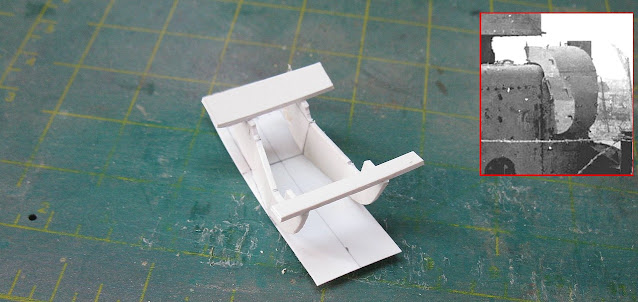Tankers!!!
The tank in this article marks a transition in the UK's Armored History. It features a few characteristics of WWI infantry tanks (like the various machine guns scattered around the hull) and the new architecture of the most modern vehicles, such as the 360° rotating turret. It was a landmark in the interwar period, providing services and experience from the 1920s until the early days of WWII. Meet the Vickers Medium Mark II.
 |
| The girl is really in serious trouble... |
 |
| Vickers Medium Mk II* tank of the Royal Tank Regiment at Farnborough, 1940. The Hobby Boss box art above must have been based on this photo... IWM - H 1148 |
History:
The Vickers Medium Mark II was a British tank built by Vickers in the Inter-war period.
 |
| Vickers Medium Mk II tank of the Royal Tank Regiment on manoeuvres at Bovington Camp, Dorset, November 1939 font: IWM - H 233 |
She was a derivation from the Vickers Medium Mark I, was developed to replace the last of the Medium Mark C Hornets still in use. The production and rebuilding programs for the Vickers Medium Mark II ran from 1925 to 1934.
 |
| Medium C Hornet tank in trials November -1926 |
The tank was phased out of service from 1939, replaced by the A9 Cruiser Mk I .
 |
| A9 Cruiser Mk I tanks on the rough terrain, near Tobruk, 12 September 1941 font: IWM E 5547 |
The MkII tank featured several improvements over the Vickers Mark I: a higher superstructure with the driver's cupola on top of it instead of in front of it; an improved suspension protected by armour skirts; and Rackham clutches, providing a primitive form of mechanical servo-control. Due to a slightly higher weight its rated speed was somewhat slower than that of the Medium Mark I, at 21 km/h compared to 24 km/h.
 |
| Comparison drawings between the Vickers Medium Mk I and Mk II |
Design:
The Mark II used the same chassis, suspension and transmission as the Medium Mark I but had a new superstructure. The Mark II was equipped with an Ordnance QF 3 pounder 2 cwt (47 mm) MkII gun. The four air-cooled .303in Hotchkiss light machine guns that were installed in the turret in early versions of the Vickers Mk I have been eliminated in this Mk II version, leaving only the coaxial machine gun for the main gun, which was a Vickers water-cooled .303 (7.7 mm) machine gun type, as well as two identical guns on the sides of the hull, near the rear. These side MG's were also withdrawn by the crews as their operational use was too restricted. This adequacy of armament shows the evolution of tactics and philosophies of armored weapon use in the period before and at the beginning of the Second World War.
 |
| British Vickers water-cooled .303 (7,7mm) machine gun |
Operational use:
The Vickers Medium Mark II and its predecessor the Vickers Medium Mark I replaced some of the Mark V heavy tanks.
 |
| Vickers Medium Mk 1 tank of the Royal Tank Regiment at Colchester. England - November 1939. font : IWM - H 194 |
 |
| Mark V heavy male tank in muddy terrain font: IWM Q 14485 |
Both tanks equipped the Royal Tank Regiments until they were phased out starting in 1938. The tanks saw their first combat use when two were used against the Mohmands on the Northwest Frontier of British India during the Mohmand campaign of 1935.
In November 1939, some Medium Mark IIs were sent to Egypt for experiments being conducted by Major-General Sir Percy Hobart and his Mobile Division (Egypt), but the Vickers Mediums in Egypt were also phased out before Italy declared war in June 1940. The Mediums were used for initial instruction in driver training.
 |
| A Vickers Medium Mk II in a photo posed in front of the Great Pyramid of Cheops, Egypt - 1939. |
 |
| A line formation of Vickers medium Mk II tanks, in two-tone (sand and brown) disruptive camouflage, in the Egyptian desert.- 1940. |
 |
| A Vickers Medium MkII in the desert. Notice the rear door opening to right and the thermal asbestos layer over the armoured skin of the tank. |
 |
| Vickers Medium tanks and other vehicles roaring in the Egyptian desert.- 1940. |
In Europe, in a desperate measure England at least had more tanks available in the face of the Nazi threat across the Channel.during the threat of German invasion in the summer of 1940, some of these outmoded vehicles were reactivated for a short time.
In Africa, no "mobile" Vickers Mediums faced the Italian invasion of Egypt in September 1940, but at least one was dug in as an armoured pillbox in the British defenses at Mersa Matruh at the time of the invasion. Later on the Australians apparently dug these two tanks out. One was returned to working order while the other, apparently damaged too far gone to warrant repair, was mounted in the back of a lorry and driven around. Later still both tanks fell into German hands, but, besides being objects of curiosity, don’t appear to have been used.
Variants:
- Mark II: the original version of which 91 were built. This version featured machine guns and a flat roof, without a cupola, on the turret.
 |
| Vickers Medium Mk II tank right front view font: IWM MH 11707 |
 |
| Vickers Medium Mk II tank left view font: IWM MH 11706 |
 |
| Vickers Medium Mk II tank right rear view font: IWM MH 11704 |
- Mark II* (star): Fifty-six of the same vehicles with the Hotchkiss machine guns removed, a coaxial Vickers machine gun added and the commander's post shifted somewhat further back as in the original position he had been in a very real danger of being hit in the stomach by spent shells ejected by the main gun's breech block. More characteristic was the presence of a cupola for the commander on the roof of the turret, called Bishop’s Mitre.
 |
| Vickers Medium Mk II * (star) tank of the Royal Tank Regiment. Notice the Bishop’s Mitre cupola in the turret's roof. fornt view - Farnborough, 1940 font: IWM- H 1148 |
 |
| Vickers Medium Mk II * (star) tank of the Royal Tank Regiment rear view - Notice the rear door, opening to left. Farnborough, 1940 font: IWM- H 1149 |
- Mark IIA: Twenty vehicles newly built in 1930. The bevel was removed from the rear of the turret and an armoured electrical ventilator fan added on the left side.
 |
| Vickers Medium Mk IIA tank (left side view) Notice the armoured ventilator in the midle left side font:IWM KID 113 |
 |
| The same Vickers Medium Mk IIA tank T427 photographed at Lulworth. CS on the side stands for Central Schools, not Close Support. (right side view) |
- Mark II** (stars): in 1932 the remaining 44 Mark II's were brought to Mark II* standard; in addition a wireless set was fitted in an armoured container at the back of the turret. the weight rose to 13.5 short tons (12.2 t).
 |
| Vickers Medium Mk II** (stars) tank rear left view font: IWM |
 |
Vickers Medium Mk II** (stars) tank left view font: IWM KID 206 |
- Mark IIA*: the twenty Mark IIA's brought to Mark II** standard. Externally, there are no differences between the MkII** and MkIIA* types.
- Medium Mark II Tropical (Mk IIA): in 1928 five tanks were shipped to Egypt. They were modified by fitting insulation against the heat, such as spaced asbestos plates on the upper surfaces. How effective they were in reducing the internal heat is not clear.
%20with%20asbestos.jpg) |
| A Vickers Medium MkII Tropical clad in panels of thermal asbestos for service in Egypt, but for some reason this tank dont show the Bishop’s Mitre turret cupola. |
- Mark IIA CS: some Mark IIAs were later rebuilt as close support vehicles, their main armament replaced by a 15-pounder 3.7 inches (94 mm) howitzer, mainly intended to give smoke cover, though some HE shells were also carried. Each company headquarters was equipped with two of these vehicles. The weight was increased to 14 tons.
 |
| A Mark IIA CS (close support) DECISION with his 15 pdr. 3.7 inches (94 mm) howitzer in high elevation. 4th Battalion, Royal Tank Corps. |
- Mark C: was never ordered by the British army, and was built exclusively for export. The main gun was a 57 mm 6-pouder gun, like the ones used on the WWI tanks. There was also a machine gun in the turret, but it was located in the rear, inside the turret bustle. In order to compensate for the lack of a coaxial machine gun, the designers installed another machine gun in the front of the hull, in addition to the two on the sides of the hull. Vickers engineers decided to place a door in the right part of the front, in a truly a strange position. A prototype of the Medium Tank Mk.C was finished in 1926. The British army put the tank through trials and quickly rejected it. On the other hand, a foreign customer was found quickly, with the Japanese bought the tank in 1927, and it became the progenitor of the Type 89 medium tank. Curiously enough, the Japanese kept the door in the front, the hull gun, and the curious arrangement of the armament in the turret.
 |
| Vickers Medium Mk.C prototype left rear view |
 |
| Vickers Medium Mk.C prototype in trials right view |
 |
| Vickers Medium Mk.C prototype front right view Notice the door in the right, the front MG in the left and the Japanese insignia in the font of the hull |
- Mark D: the Vickers Mk. D was a one-off design built for the Irish Free State and delivered in 1929. Only one was built. It was almost identical (even mechanically) to the Mk.C, with the difference being the presence of a cupola for the Commander on top of the turret. They had a water cooled, rear mounted, 6-cylinder Sunbeam Amazon petrol engine, developing 170 bhp (130 kW) at 2100 rpm. A 6 pdr gun was fitted and as many as four Vickers .303 (7.7 mm) machine guns. This tank was scrapped in 1940.
 |
| Vickers Medium Mk.D - Irish tank Notice the cupola in the turret... font: Youtube |
 |
| Vickers Medium Mk.D - Irish tank Notice the cupola in the turret and the weird front door. font: Youtube |
- Medium II Bridgecarrier: In 1926, a Mark II number T145, an Ordnance Factory tank, was adapted to carry bridging components, an experimental project to convert any Mark II optionally into a bridgecarrier by fitting the bridge girders to the vehicle together with a contraption to launch the bridge when finished. This proposal was not adopted.
 |
| The experimental Medium II (T 145) Bridgecarrier, showing its engineering accessories, on the sides of the hull. |
- Medium II Female: Under the command of Lieutenant J.T. Crocker in 1927 two tanks were built for the Indian Government. The turret had no main gun but only two Vickers machine guns. There were also no machine guns on the sides of the hull. Although they were in fact Medium II's and always called that way, their official designation was Tank Light Mark IA Special (L) India.
 |
| One of the pair of Medium II Female tanks.in India. They performed reasonably well but were not popular. After trials, both tanks were shipped back to Britain and duly scrapped. |
- Medium II Box Tank: This was a single command tank, converted from a Medium II , the T236, also built by the Ordnance Factory in 1926, by removing the turret from the fighting compartment and fitting a large rectangular superstructure. Its only armament was a single machine gun in a ball mounting in the front of that armoured box. Two radio sets were fitted: a short range set for tactical communication and a long range one to contact higher levels. The Box tank was first used by a battalion commander and from 1931 by the Brigade Commander.
 |
| Medium II Box Command Tank (T-236) in parade, seen here with the French General Maxime Weygand as a passenger, taking the salute. This tank normally served with 5th Battalion, but also was used to command larger formations such as brigades. |
 |
| The unique Medium II Box Command Tank (T-236), in field maneuvers. |
- Medium Mark II* Special: Four Mark II tanks from a Vickers contract dated 26 August 1926 and numbered T221 to T224 by the British system were completed for the Australian Army, arriving in Australia in September 1929. These tanks had as their main feature a turret without a commander's cupola (a flat hatch with two covers) and the lateral bevels of the turret much smaller than the English versions. These tanks were not decommissioned until around 1942, but they never underwent the upgrades that British tanks did, such as Bishop’s Mitre cupolas or wireless armored boxes fitted to the rear of turrets. One such tank survives and is on display at the Royal Australian Armored Corps Museum in Puckapunyal, Victoria.
 |
| Aussie Vickers Medium MkII* Special tank Notice the details in the turret. |
 |
| Aussies Vickers Medium MkII* Special tanks Notice the details in the turret. |
- Medium Mark II* Command Tank: in 1931 another command tank was created for the Tank Brigade by replacing the main armament by a dummy gun, fixing the turret in place and fitting an additional wireless set in the space thus gained.
%20IWM%20KID%20117.jpg) |
Vickers Medium Mk II*(star) Command tank Notice the big aerial in the midle right side of the tank. The turret is bolted in place. font: IWM KID 117 |
- English Workman: the nickname given by the Russians to 15 (or 16) Vickers Medium Mk.IIs purchased in 1931. This variant had no cupola, less pronounced turret bevels, and cowled ventilation fans on the hull sides. About half a dozen were found without engines or guns by Finnish forces near Vitele in autumn 1941 during the Continuation War.
 |
| Russian Vickers Medium Mk.II English Workman Notice the absence of turret cupola, the less pronounced turret bevels and Maxim machine guns in the sides of the turret |
- Birch gun: three prototypes built between 1926 and 1929 of a self-propelled gun for the experiments then conducted in the field of mechanised warfare. The Mark I had the Ordnance QF 18 pounder, The Mark II chassis was lengthened and fitted with a 75 mm gun on a mounting capable of high elevations.
 |
| Birch gun 18 pdr. SPG front right view |
 |
| Birch gun 18 pdr. SPG rear left view |
 |
| Birch gun 18 pdr. SPG with its gun in max elevation front right view |
Surviving vehicles:
Three Vickers Medium Mark II tanks have survived around the world.
- T199 is preserved at The Tank Museum in Bovington, Dorset, England.
 |
| Vickers Mk II T199 at Tank Museum - Bovington, |
- A Vickers Mk IIA without main gun, has survived at the U.S. Army Center for Military History Storage Facility, Anniston, Alabama (USA).
 |
| Vickers Medium Mk IIA. at the United States Army Ordnance Museum (Aberdeen Proving Ground, MD) on June 12, 2007 Picture by Mark Pellegrini |
- A vehicle has survived at the Royal Australian Armoured Corps Tank Museum, Puckapunyal, Victoria Australia.
%20in%20Royal%20Australian%20Armoured%20Corps%20Tank%20Museum,%20Puckapunyal,%20Victoria,%20Australia..jpg) |
| Vickers Medium Tank Mk II (Special) at Royal Australian Armoured Corps Tank Museum Puckapunyal, Victoria - Australia. |
 |
| Thanks for the image, Brown William |
Specs:
| Vickers Medium Mark II** | |
|---|---|
| Type | Medium tank |
| Place of origin | UK |
| Service history | |
| In service | 1925–1939 |
| Production history | |
| Manufacturer | Vickers |
| Specifications | |
| Mass | 12.2 long tons |
| Length | 5.33 m |
| Width | 2.82 m |
| Height | 2.69 m |
| Crew | 5 |
| Armour | 6.35 mm to 8.0 mm |
Main armament | QF 3-pounder (47 mm) |
Sec. armament | 4 × 0.303 (7.7 mm) Hotchkiss M1909 Benét–Mercié mg 2 × 0.303 Vickers mg |
| Engine | Armstrong Siddeley V-8 90 horsepower (67 kW) |
| Power/weight | 8 hp/ton |
| Suspension | helical springs |
Operational range | 193 km |
| Maximum speed | 25.1 km/h |
The kit:
For this commission project, my client would like to do something similar to this photo:
 |
| A captured Vickers Mk II** with desert cammo being inspected by a German soldier. |
The problem is that even though he looked a lot for the Vickers MkII** Hobby Boss kit, he only found the MkI* kit, without the radio compartment, in the stern of the turret:
 |
| The box art of Hobby Boss Vickers Medium Tank MK II** kit (#83881) with the radio compartment at the back of the turret. (red arrow) |
He asked me if I was up for the challenge of making this piece and a few more details in scratch and the answer was: Why not??? Let's have some fun then, with the kit provided by the client.
 |
| Hobby Boss Vickers Medium Tank MK II* (#83880) with Kojak, in my workbench... |
But first, let's start with the basics: following the booklet... Starting construction with the suspensions. Here, a small detail: leave the bogies with the central pin just fitted, mobile, without gluing. This will make it easier to adjust and align the suspension in the future.
 |
| Building the suspensions... Leaving the bogies mobile prevents future misalignments... |
 |
| Quiet step to build...Lots of wheels, but for someone who has already built 200 AFV Club Churchills, this is child's play!! |
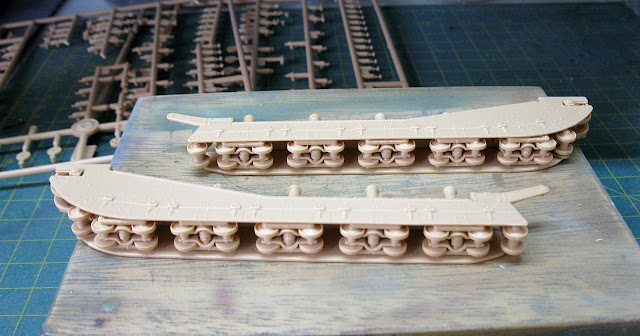 |
| The suspension assemblies built... |
 |
| ...and with the mobile bogies, it is very easy to align them horizontally, without defects...´ Just apply a drop of cement on the joints and... Voiláá |
 |
| My client asked that this vehicle had the lateral armament in the hull. No heresy here... Vickers submachine guns are simply beautiful... |
 |
| He also asked for some open hatches... I painted the interior off-white... |
 |
| The thing going well...sets of suspensions installed in the hull: Tommy is happy!!! |
 |
| right side view |
 |
| Rear view. Notice the fuel caps... |
 |
| Front view. |
Well... as you remember, it all started with this image...It appears to be one of the Vickers Mk II Medium used as pillboxes that were unearthed by the Australians at Mersa Matruh and later captured by the Germans in 1941.
 |
| Vickers Medium Mk II** being inspected by Germans |
 |
| Notice the details of this vehicle: radio compartment (dark green arrow), the air intake in the rear door (blue arrow) |
missing hinges on the left side (red arrows)
and the handle to climb into the tank on the left side (light green),
which indicates that the rear door of this vehicle opens to the right.
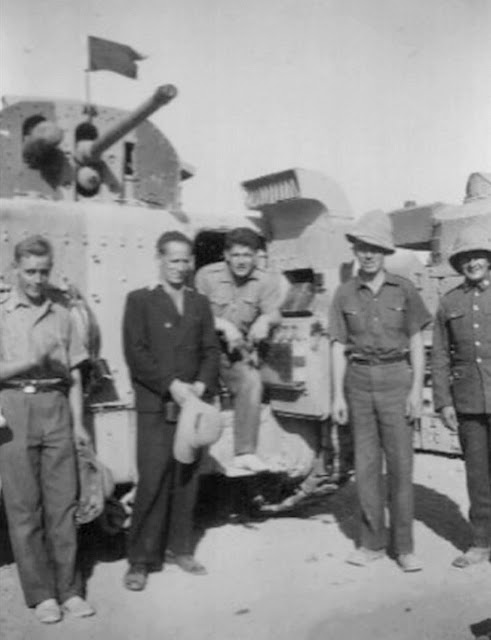 |
| Rear door opening to the right. |
As ALL versions of Hobby Boss kits open the door to the left, the option is to invert everything, with a little scratch, to be as faithful as possible to the vehicle in the photo. You see, I will not EXACTLY reproduce the moment of the photo, but the vehicle in a phase prior to this photo. Even with the side guns installed (another request from my client...)
 |
| Schematic drawing of the rear door modification |
In my research, I didn't find out exactly why the English reversed the direction of the door opening, although the direction of opening to the right seems more logical to me, with the door "touching" and protecting the position of the tracks...
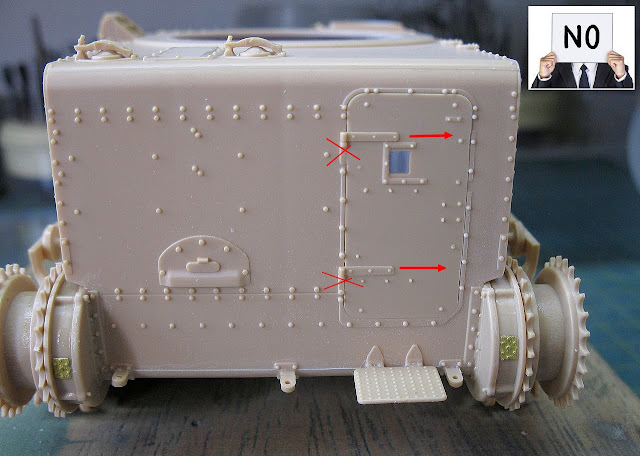 |
| The door opening to the left... NOOO! Let's change the position of the hinges on the door and eliminate those on the hull. |
 |
| The "standard" door, with the hinges on the left... |
 |
| The new door, with the hinges on the right... |
 |
| Testing the hinges, in place... so far, so good!! |
I already told you that I hate link-by-link tracks, even more with links with sub-constructions... And this kit has these infamous tracks... Grrrrr .... But there's no use complaining: let's face the purgative with stoicism (which is what I have left...)!!
 |
| 132 pieces of joy, in total!!! |
 |
| Testing the track adaptation on the suspension... |
 |
| A complete track already installed... half of the martyrdom already suffered... |
 |
| And 3 hours after blasphemies and imprecations to the Gods of modelism... Hurrah... The damn thing was done!! Our colleague standing on his own paws!!! |
 |
| Tracks in position: right view |
 |
| What a relief, Gods... what a relief to have gone through this Valley of Shadows and Tears with even a hint of sanity !!!! |
 |
| And isn't the little girl (not that little...) cute??? My client requested that some hatches remain open... after all, it's very hot in the desert and our heroine doesn't have the asbestos suit... |
 |
| Right view. |
 |
| Here, an example of recycling, hard level: the rivets that must be removed from the front of the turret were reused in the door hinges!!! Greta was speechless!!! |
The construction of the kit, in the standard form, is practically ready...
 |
| Adding final "organic" details to the Vickers kit... |
 |
| Really a very nice kit... |
But now, the party begins: let's work a little with scratch, old school... No 3D printing: just plasticard, pencil and scalpel!!! First step: making the rear door air-filter-fan intake. Photos, drawings and dedication for this stage...
 |
| Drawing and cutting the sides and "back" of the air intake... |
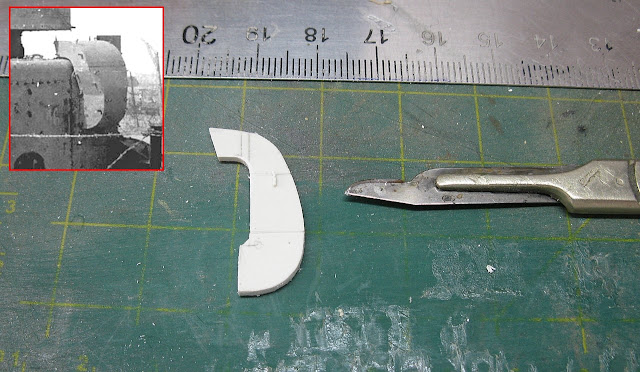 |
| The air intake side in detail... |
 |
| After the air intake is ready, we will test its position on the door... |
 |
| Rear view... |
 |
| Like a glove!!! |
 |
| Front view... |
 |
| Adding the part's structural reinforcements. I just LOVE my Plastruct's stuff!! |
 |
| Rear view |
 |
| Right view |
 |
| Adding a screen to the air intake... |
 |
| Now let's take care of the beauty of the "nape" of the turret! Radio compartment made with plasticard and Plastruct... |
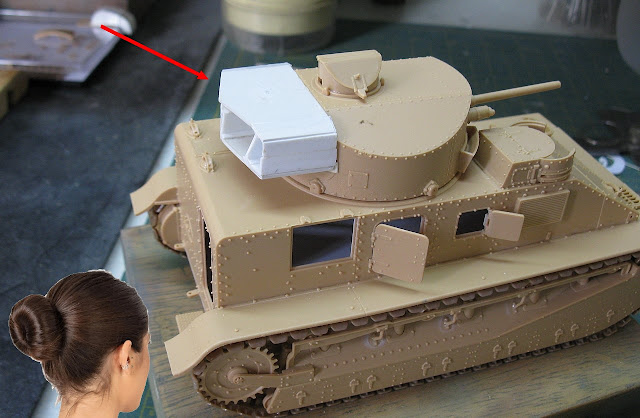 |
| The radio compartment taking shape... |
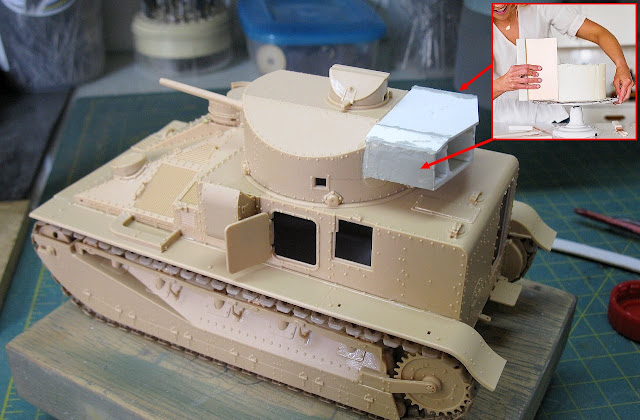 |
| Rectifying the "cake frosting" with putty!! left view |
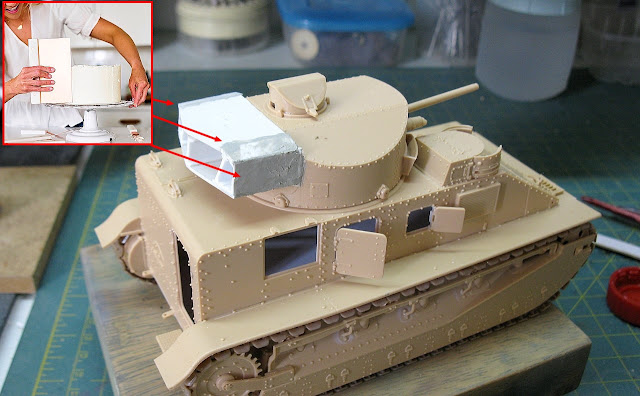 |
| Rectifying the "cake frosting" with putty!! right view |
 |
| After everything dried and sanded, the final result! |
 |
| Me (and Kojak) very satisfied!!! |
 |
| Now yes...Our Vickers Mk II evolved into Vicker Mk II** |
 |
| Right view. Notice the antenna, made with an acupuncture needle and the details in PE from the kit. |
 |
| Hell, she REALLY is getting pretty!!! Notice the the support of the plate, made with leftover PE, in the upper right corner of the back of the hull. |
 |
| Front left view |
 |
| Left view |
 |
| Rear view. Notice the door hinges, in the hull... |
 |
| Yes... I'm very, very satisfied, indeed!! |
 |
| The girl, almost ready... right view |
 |
| Soooo coool!! |
 |
| Two British legends, by Saint George!!!!!! |
But back to construction, let's not forget that the back door will be built open... So I need to detail the inside of this door. Thankfully there is a photo with some details showing... Time for some plastic surgery!!
 |
| Building internal details of the door: opening the outlet (or inlet...) of the air intake, in a rectangular shape and a "lining"with 0.3mm thick plasticard. |
 |
| And all this together. Notice the lock, the handle, the internal filter, etc... The thing turned out decent!!! |
While the door detail dries, we'll use a primer to prep the paint.
 |
| Light gray primer...left view |
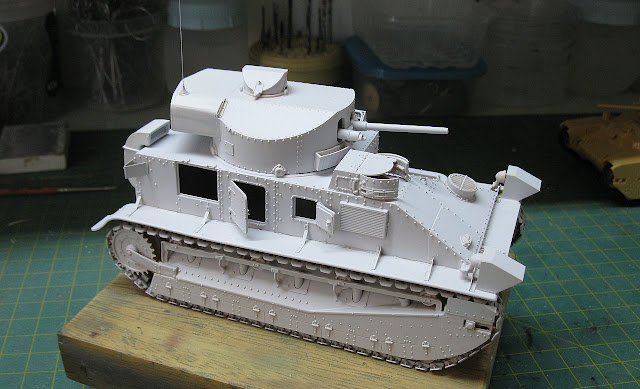 |
| Light gray primer...right view |
 |
| Light gray primer...rear view. The rear door is only fitted, not glued... |
Many must be asking: what about the rivets on the radio compartment and the air intake?? Well then, I'm going to use the decals of rivets in resin from the extinct Archer Decals. I use it after the primer, because the relief is not as clear as those injected in plastic and if I use the primer after applying the decals, these rivets are not very prominent, clear.
 |
| Rosie, the riveter only works after primer... Notice in the open left side hatch, the lining detail that was built... |
 |
| Notice in the open right side hatches, the lining details that was built... Too bad Archer no longer manufactures this and other gem!!! Why Archer??? Why??? |
 |
| Rivets on radio compartment and air intake... All sealed with Pledge!! |
 |
| The difference in "volume" between Archer and injected rivets is clear. That's why I apply them AFTER the primer. |
After research about the vehicle, I made a change to the drawings in War Drawings, to serve as a guide for markings and colors: the Vickers Medium Mark II**, belonged to the 6th Battalion, Royal Tank Corps, was formed in Egypt in 1933. The tank appears in its latest version, without the thermal asbestos, but still with the markings intact, and would later be captured by the Germans in 1940.
First of all, a pale cream base coat, with lighter and darker tones, on the vehicle::
 |
| Base color with pale-cream with tones. |
 |
| Rear view, with rear door glued in position... |
 |
| Rear view, with rear door glued in position... Notice the door's details... |
 |
| Left view |
 |
| Front left view |
My customer requested that the secondary armaments of the hull be installed. Here's a good option, because the Vickers are simply beautiful in this kit... and give a more bellicose touch to the set...
 |
| The girl with her guns...really, she gets more dangerous!!! But they will only be installed at the end of construction, to avoid accidents... |
As the vehicle will be represented as if it were stationary, with the crew at rest, I will leave the upper hatches of the weapons posts half-open!! All in the name of heat!!!
 |
| Right view. Notice the the upper hatch of the MG post half-open. |
 |
| Rear view |
 |
| Left view. Notice the the upper hatch of the MG post half-open. |
 |
| The red identification band, painted on the turret. left view |
 |
| The red identification band, painted on the turret. rear view |
 |
| The red identification band, painted on the turret. right view |
 |
| The red identification band, painted on the turret. front right view |
 |
| Installing the secondary Vickers machine guns, on the sides of the hull... True badass girl!!! left view |
 |
| Installing the secondary Vickers machine guns, on the sides of the hull. right view |
 |
| Internal view of the machine guns... left side |
 |
| Internal view of the machine guns... right side |
 |
| Tracks in gun-metal |
 |
| Decal made with transparent decal +laser print Starting the weathering... |
 |
| Rear view |
 |
| Notice the markings in the front air intake |
And after a few weathering and fraying sessions, here's our Vickers Medium Mark II** (stars) tank, belonged to the 6th Battalion, Royal Tank Corps, was formed in Egypt in 1933. The tank appears in its latest version, without the thermal asbestos, but still with the markings intact, before its capture by the Germans in early 1940.
 |
| Vickers Medium Mark II** (stars) tank 6th Battalion, Royal Tank Corps - Egypt early 1940. |
 |
| Vickers Medium Mark II** (stars) tank front left view |
 |
| Vickers Medium Mark II** (stars) tank front left top view |
 |
| Vickers Medium Mark II** (stars) tank left view |
 |
| Vickers Medium Mark II** (stars) tank rear left view |
 |
| Vickers Medium Mark II** (stars) tank rear left top view |
 |
| Vickers Medium Mark II** (stars) tank rear right view |
 |
| Vickers Medium Mark II** (stars) tank rear right view |
 |
| Vickers Medium Mark II** (stars) tank right view |
 |
| Vickers Medium Mark II** (stars) tank right top view |
 |
| Vickers Medium Mark II** (stars) tank front right view |
 |
| Vickers Medium Mark II** (stars) tank front right view |
 |
| Vickers Medium Mark II** (stars) tank with Kojak and Rover, the dog!! |
 |
| Two desert girls: Vickers Medium Mark II** (stars) tank and British Cruiser A15 tank Crusader Mk I - 2pdr gun |
Thank you for following this project...






